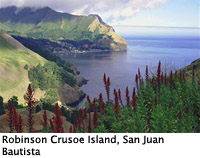Here’s the forty-fifth installment of LiteratEye, a series found only on The Art of the Prank Blog, by W.J. Elvin III, editor and publisher of FIONA: Mysteries & Curiosities of Literary Fraud & Folly and the LitFraud blog.
LiteratEye #45: How to Keep That New Year’s Resolution? Take It Along to a Desert Island
By W.J. Elvin III
January 1, 2010
 Happy New Year to all, especially to those who’ve signed on as friends at the Art of the Prank site on Facebook – it’s intriguing to see some of the people you’re writing to, or to try to guess who might be behind that weird picture.
Happy New Year to all, especially to those who’ve signed on as friends at the Art of the Prank site on Facebook – it’s intriguing to see some of the people you’re writing to, or to try to guess who might be behind that weird picture.
So, have you made a resolution never to do that again, whatever that was? Good luck. Probably the only way to keep your resolution is to go live on a desert island like Robinson Crusoe.
But then, Robinson Crusoe is a literary character, he never really existed. As mentioned in LiteratEye #22, the story is based largely on the adventures of Alexander Selkirk, marooned on the island then known as Aguas Buenas, off the coast of Chile.
It is now officially Robinson Crusoe Island.
Daniel Defoe took a lot of heat for deception because he presented the book as a true memoir, the work of Crusoe.
Even to this day he takes heat for it, as evidenced in Nicholson Baker’s comments in the Columbia Journalism Review: “Robinson Crusoe is Defoe’s most famous hoax. We describe it as a novel, of course, but it wasn’t born that way. On its 1719 title page, the book was billed as the strange, surprising adventures of a mariner who lived all alone for eight-and-twenty years on an uninhabited island, ‘Written by H I M S E L F’-and people at first took this claim for truth and bought thousands of copies.”
Baker passes along a quote from early Defoe biographer William Minto: “He was a great, a truly great liar, perhaps the greatest liar that ever lived.”
In recent years the island generated yet another hoax. A company called Wagner Technologies announced that it’s robotic metal detector had located a fortune – possibly eight or ten billion dollars – in gold, silver and jewels on the island.
Gotta love the robot’s inventor, Manuel Salinas, who is credited with “fantastic and seemingly irrational theories to explain how his machine worked.” As you will note from the Wikipedia entry, the robot seems to have actually found some things – a buried arms cache and a missing body.
The desire to believe the treasure tale was fueled by several legends of huge quantities of looted Aztec gold and gems, and other pirate loot supposedly buried there.
The search – if there really was a search at all — generated international media attention and suckered Chilean officials who got busy with plans to divvy up the haul. Then the company announced that the treasure was buried too deeply for them to go after.
Well, they claimed the treasure was fifty feet down. What do you think? Fifty feet doesn’t seem so far. Get some experts from the Mexican drug cartels if they are not too busy undermining the magnificent border fence.
Back to Robinson Crusoe Island. Is it really a desert island?
The island, part of the Juan Fernandez group, is over 400 miles west of the coast of Chile in the Pacific Ocean. There are around 600 inhabitants, reportedly a happy group quite content to let the rest of the world go by.
Despite promotional efforts, not many tourists visit the island. Charter flights are available from the mainland, sometimes. Or, with luck, you might catch a fishing boat or supply boat headed that way from the port at Valparaiso. From the lone airstrip, which experts said could not be built, it is a long way to town – ninety minutes by boat.
Spanish is the primary language.
Lobsters abound.
And could you really play Robinson Crusoe there? From the reports I’ve seen, much of the island is tropical jungle and it is quite easy to “get lost.”
photo: Unique-SouthAmerica-Travel-Experience.com. [Check here also for a travel video about Robinson Crusoe Island]
(Copyright 2009 WJE, exclusive to The Art of the Prank, for reprint rights contact Literateye@gmail.com)
Check out previous LiteratEye episodes on The Art of the Prank.
